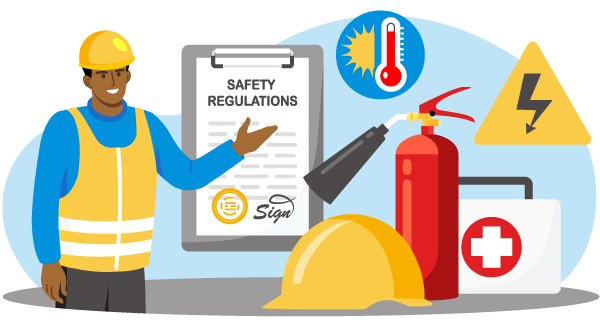
Power washing may seem simple—point, spray, clean—but behind every job is real risk. From high-pressure water jets and chemical exposure to ladder falls and electrical hazards, job site safety is no joke. Yet many small businesses operate without clear safety protocols in place—until something goes wrong. 😬
If you want to protect your crew, your business, and your reputation, it’s time to establish real safety standards and enforce them with confidence.
Here’s how to create a safe, compliant, and professional work environment for your power washing business. 🧼🦺✅
Why Safety Must Be a Core Priority 🧠💡
Skipping safety might save a few minutes—but it can cost you everything.
✅ Prevents injuries and liability
✅ Reduces downtime and equipment damage
✅ Boosts crew confidence and professionalism
✅ Meets insurance and legal requirements
✅ Helps win commercial contracts (many require documented protocols)
Being safety-conscious isn’t just about rules—it’s about creating a culture of care.
1. Identify the Key Hazards in Power Washing 🚨🧯
Start by knowing the risks:
🔹 High-pressure water – Can cut skin or damage eyes
🔹 Ladders and falls – Especially when wet or on uneven surfaces
🔹 Chemical exposure – Can burn skin, eyes, or lungs
🔹 Slip and trip hazards – Wet surfaces, hoses, and cords
🔹 Electric shock – Especially near outlets, fixtures, or electric panels
🔹 Flying debris – Paint chips, dirt, or rust flakes
🧠 The first step in job site safety is knowing what to look out for.
2. Develop a Written Safety Policy 📄🖊️
Every business—no matter how small—should have a formal safety plan. Include:
✅ Job-specific hazards and required safety procedures
✅ PPE requirements (gloves, goggles, boots, etc.)
✅ Ladder and scaffold usage
✅ Chemical handling and storage protocols
✅ Emergency procedures
✅ Incident reporting guidelines
💡 Make it part of your onboarding, keep it in vehicles, and review it quarterly.
3. Provide Proper PPE (Personal Protective Equipment) 👷♂️🧤
Don’t assume your techs will bring their own gear or know what’s needed.
✅ Supply and require:
- Safety goggles
- Gloves (chemical-resistant and grip-based)
- Waterproof boots
- Ear protection (for noisy machines)
- Masks or respirators (for chemical use)
🧠 Replace worn or broken gear immediately—skimping on PPE can lead to major injuries and lawsuits.
Browse Amazon Here For Power Washing Safety Gear
4. Train Every Employee Thoroughly 🎓🛠️
A safety manual means nothing without training.
✅ Conduct hands-on safety sessions at least quarterly
✅ Train on equipment use, chemical mixing, ladder setup, and job site walk-throughs
✅ Use real-life examples of what can go wrong
✅ Test understanding with brief quizzes or checklists
📸 Bonus: Document training sessions for your insurance records and commercial job proposals.
5. Create a Pre-Job Safety Checklist 📋✅
Before every job, crews should run through a short safety checklist:
🔲 Walk the perimeter of the property
🔲 Identify electrical hazards or loose debris
🔲 Inspect all ladders, hoses, and nozzles
🔲 Confirm water access and drainage points
🔲 Ensure proper PPE is being worn
🔲 Check for pets, children, or foot traffic zones
🧠 Make this a daily habit—5 minutes can prevent serious incidents.
6. Manage Chemical Handling with Care 🧪⚗️
Soft washing and degreasers can contain strong or caustic agents.
✅ Store chemicals in clearly labeled, sealed containers
✅ Never mix chemicals unless instructed to
✅ Train on MSDS (Material Safety Data Sheets) for each solution
✅ Use designated containers and sprayers to avoid contamination
✅ Always wash hands thoroughly after use
💡 Tip: Keep a printed MSDS binder in every rig or van—especially for OSHA inspections or emergencies.
7. Follow OSHA Guidelines and Local Regulations ⚖️📚
Even small service businesses are expected to follow federal safety rules.
✅ Visit OSHA.gov for service-industry-specific guidance
✅ Stay compliant with:
- Ladder safety
- Fall protection
- Hazard communication (chemical labels)
✅ If you hire employees, you may need: - OSHA poster displayed in your office
- First aid kits on all job sites
- Annual training logs
🧼 Remember: Even one injury can trigger inspections or insurance complications.
8. Require Job Site Walkthroughs by Team Leads 🚶♂️🔍
Appoint a crew lead or manager on each job to:
✅ Conduct pre- and post-job safety walk-arounds
✅ Report hazards or near-misses immediately
✅ Ensure the crew follows PPE and ladder safety rules
✅ Serve as point-of-contact in emergencies
🧠 This structure improves accountability and consistency.
9. Log All Incidents and Near Misses 📓🚑
Even if no one was hurt, document the event.
✅ Record what happened
✅ What conditions caused it
✅ What was done to prevent recurrence
✅ Who was involved and witnessed it
📁 Keep these records securely—this is vital for:
- Insurance claims
- Internal training
- Job site improvements
Final Thoughts 💬
In power washing, safety isn’t a box to check—it’s a foundation for success. With the right systems in place, you’ll:
- Protect your people
- Prevent liability
- Win commercial contracts
- And run a cleaner, more professional operation
Because the only thing better than sparkling surfaces is sending everyone home safe, every single day. 🧼🦺✅
Browse Amazon Here For Popular Pressure Washers And Accessories






